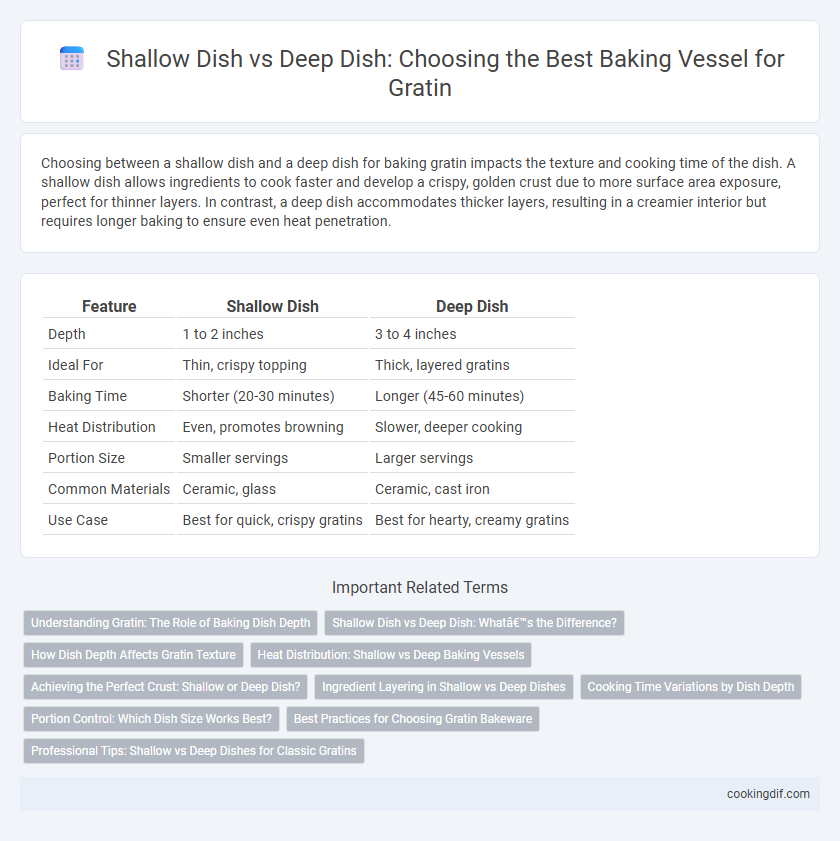Choosing between a shallow dish and a deep dish for baking gratin impacts the texture and cooking time of the dish. A shallow dish allows ingredients to cook faster and develop a crispy, golden crust due to more surface area exposure, perfect for thinner layers. In contrast, a deep dish accommodates thicker layers, resulting in a creamier interior but requires longer baking to ensure even heat penetration.
Table of Comparison
| Feature | Shallow Dish | Deep Dish |
|---|---|---|
| Depth | 1 to 2 inches | 3 to 4 inches |
| Ideal For | Thin, crispy topping | Thick, layered gratins |
| Baking Time | Shorter (20-30 minutes) | Longer (45-60 minutes) |
| Heat Distribution | Even, promotes browning | Slower, deeper cooking |
| Portion Size | Smaller servings | Larger servings |
| Common Materials | Ceramic, glass | Ceramic, cast iron |
| Use Case | Best for quick, crispy gratins | Best for hearty, creamy gratins |
Understanding Gratin: The Role of Baking Dish Depth
Shallow dishes allow for faster, even cooking and develop a crispier, golden crust on a gratin due to greater surface exposure to heat. Deep dishes retain more moisture, resulting in a creamier texture but may require longer baking times to ensure the center is fully cooked. Choosing the right baking vessel depth directly influences the gratin's texture, cooking time, and flavor concentration.
Shallow Dish vs Deep Dish: What’s the Difference?
A shallow dish allows for faster, more even cooking and a crispier gratin crust due to its larger surface area exposure to heat, while a deep dish retains more moisture and creates a creamier interior by design. Shallow dishes excel in browning and offer easier serving portions, whereas deep dishes accommodate thicker layers and more volume, affecting texture and baking time. Choosing between shallow and deep gratin dishes depends on the desired balance of crust crispness versus creamy interior consistency.
How Dish Depth Affects Gratin Texture
Shallow dishes promote faster evaporation of moisture, resulting in a crispier, more evenly browned gratin surface with tender layers beneath. Deep dishes retain more liquid, yielding a creamier, softer interior but may cause the top to brown less uniformly. The ideal gratin texture depends on matching dish depth to desired moisture levels and cooking time.
Heat Distribution: Shallow vs Deep Baking Vessels
Shallow baking dishes promote even heat distribution, allowing gratin to cook uniformly with a crisp, golden crust. Deep dishes concentrate heat at the bottom, potentially causing uneven cooking and a softer interior with a less caramelized top. Choosing a shallow dish helps achieve balanced heat exposure for optimal gratin texture and browning.
Achieving the Perfect Crust: Shallow or Deep Dish?
Shallow dishes promote faster moisture evaporation, resulting in a crispier, perfectly browned crust essential for classic gratins. Deep dishes retain more steam, which can soften the top layer, ideal for creamier textures but less crust development. Choosing a shallow baking vessel optimizes heat exposure and enhances the Maillard reaction for that signature golden, crunchy gratin crust.
Ingredient Layering in Shallow vs Deep Dishes
Shallow dishes promote even ingredient layering, allowing heat to penetrate uniformly and ensuring a crisp, golden top layer in gratins. Deep dishes enable thicker layers, which result in a creamier interior but may require longer baking times to cook through without burning the surface. Optimal layering in shallow dishes enhances texture contrast, while deep dishes prioritize rich, hearty consistency.
Cooking Time Variations by Dish Depth
Shallow dishes promote faster cooking times for gratins due to increased surface area and heat exposure, allowing ingredients to brown and crisp more efficiently. Deep dishes require longer baking times as heat penetration is slower, often resulting in a creamier texture with less surface browning. Adjusting cooking time based on dish depth ensures optimal texture and doneness for gratins.
Portion Control: Which Dish Size Works Best?
Shallow dishes offer even heat distribution, resulting in a crispier, evenly browned gratin surface, ideal for smaller portions and precise serving sizes. Deep dishes hold larger quantities, making them suitable for family-style dining but can lead to uneven cooking and difficulty controlling individual portion sizes. Choosing the right dish depends on whether you prioritize consistent texture and portion control (shallow) or volume and sharing (deep).
Best Practices for Choosing Gratin Bakeware
Selecting the right gratin bakeware depends on the dish's ingredients and desired texture; shallow dishes promote even browning and crispier edges, ideal for vegetable gratins and thinner layers. Deep dishes accommodate larger portions and thicker casseroles, allowing flavors to meld but may require longer baking times to ensure the center cooks thoroughly. Opt for ceramic or glass materials to retain heat evenly, enhancing the gratin's golden crust and creamy interior.
Professional Tips: Shallow vs Deep Dishes for Classic Gratins
Professional chefs recommend shallow dishes for classic gratins to ensure even browning and optimal caramelization of the cheese topping. Deep dishes retain more moisture, which can result in a softer texture but may prevent the gratin from achieving its signature crisp crust. Selecting the appropriate dish depth affects cooking time and texture, with shallow options promoting quicker cooking and a crispier finish essential for traditional gratin recipes.
Shallow Dish vs Deep Dish for baking vessel Infographic

 cookingdif.com
cookingdif.com